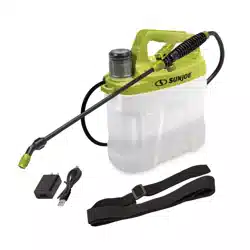Loading ...

2
be properly repaired or replaced by an authorized service
center unless indicated elsewhere in this manual.
• Keep the sprayer and its handle dry, clean and free
from oil and grease. Always use a clean cloth when
cleaning. Never use brake uids, gasoline, petroleum-
based products, or any strong solvents to clean your tool.
Following this rule will reduce the risk of loss of control and
deterioration of the enclosure plastic.
• Use this product in accordance with these instructions
and in the manner intended, taking into account the
working conditions and the work to be performed. Use
of the product for operations dierent from those intended
could result in a hazardous situation.
• Have this product serviced by a qualied repair person
using only identical replacement parts. This will ensure
that the safety of the power tool is maintained.
• When servicing the product, use only identical
replacement parts. Follow instructions in the Maintenance
section of this manual. Use of unauthorized parts or failure
to follow Maintenance instructions may create a risk of
shock or injury.
Specic Safety Rules for
Chemical sprayer
mDANGER! Risk of re or explosion. Do not spray
ammable liquids such as gasoline. Look for warning symbols
on the liquid container.
mWARNING! Some spray created from products used
with the sprayer contains chemicals that may cause harm to
health. Follow directions on containers of all such products.
To reduce your exposure to these chemicals, wear approved
safety equipment such as face masks that are specially
designed to lter out sprays, gloves, and other appropriate
protective equipment.
mCAUTION! When a ammable liquid is sprayed,
there may be danger of re or explosion, especially in a
closed room.
• Before using any pesticide or other spray materials in this
sprayer, read the label on its original container thoroughly
and follow its directions. Some spray materials are
dangerous and should not be used in this sprayer, as they
can damage the sprayer and cause serious bodily injury or
property damage.
• Electric shock hazard. Never spray toward electrical outlets.
• Do not use commercial grade chemicals or chemicals for
commercial or industrial purposes. Use only consumer
grade water-based lawn and garden chemicals.
• Do not pour hot or boiling liquids into the tank. These can
weaken or damage the hose or tank.
• Spray area must be well ventilated.
• Avoid spraying on windy days. Spray can be accidentally
blown onto plants or objects that should not be sprayed.
• Store the sprayer in a secure, well-ventilated indoor space
with the uid tank empty.
• Do not use caustic (alkali) self-heating or corrosive (acid)
liquids in this sprayer. These can corrode metal parts or
weaken the tank and hose.
• Know the contents of the chemical being sprayed. Read
all Material Safety Data Sheets (MSDS) and container
labels provided with the chemical. Follow the chemical
manufacturer’s safety instructions.
• Do not leave residue or spray material in the tank after
using the sprayer. Clean after each use.
• Do not smoke while using the sprayer, or spray where spark
or ame is present.
• Risk of injection. Do not discharge directly against skin.
• To reduce the risk of electric shock, do not put the sprayer
into water or other liquid. Do not place or store the sprayer
where it can fall or be pulled into a tub or sink.
• Maintain this product. Thoroughly inspect both the inside
and outside of the sprayer and examine the components
before each use. Check for cracked and deteriorated hoses,
leaks, clogged nozzles, and missing or damaged parts.
If damaged, have the product repaired before use. Many
accidents are caused by poorly maintained products.
• Always wear eye protection with side shields or goggles.
Failure to do so could result in uids entering your eyes
resulting in possible serious injury.
• Protect your lungs. Wear a face or dust mask when using
the sprayer. Following this rule will reduce the risk of serious
personal injury.
• Battery tools do not have to be plugged into an electrical
outlet; therefore, they are always in operating condition. Be
aware of possible hazards when not using your battery tool
or when changing accessories.
• Store the product out of the reach of children and do
not allow persons unfamiliar with the product or these
instructions to operate the product.
Loading ...
Loading ...
Loading ...
